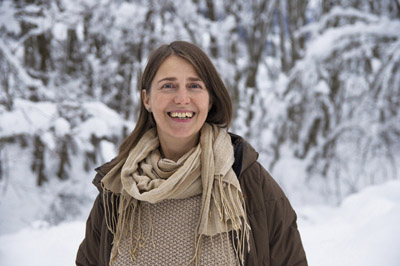
Director´s note

Foto: Bernd Beyer
Why do some people choose to resist? Where do they find the courage, even at the risk of being arrested? These are the questions driving me on as I meet the Kyrgyz environmental activist Erkingul Imankodjoeva and her fellow activists for the first time. It is autumn, 2007, and they greet me in their small, unheated office in a village in the mountains of Kyrgyzstan/Central Asia. Trained as an cultural anthropologist with research experience in Kyrgyzstan I wanted to take time in getting to know my protagonists well and to create an atmosphere of intimacy and trust between us. That is why I followed my characters over four years between 2007 and 2011 with my camera.
Following the logic of ethnographic filmmaking and the "caméra-stylo" principle I carried a camera myself. But theory wasn't my only reason for doing this. Being fluent in Kyrgyz, I am extremely close to my protagonists, and it was this closeness that motivated me to carry a camera into the thick of things with them. This approach helped me to tell the story not only through my eyes but also to give an insight into the protagonists perspective. When I have conversations with them on women and politics or bride kidnapping, we get an intimate impression of their point of view.
I have consciously tried to make transparent the development of the film. In doing so, I wanted to place my "omnipotence of interpretation" in a new disposition - at least partly.
Regardless of the film's location, the filmic observations of the environmental activist's daily life in a Kyrgyz village, touches a universal issue: it sounds out the motives for political and social commitment and considers the question of what happens when people decide to put up resistance and to stand up for their ideals. At the same time, the film also tells us - from the perspective of "common" women - about one of the most pressing global issues: the fight for raw materials and its consequences for the population and the politics of a country.
I am happy that, with this film, I am able to bring a political and ecological issue from the region of Central Asia into the festival scene. I think this is all the more important since, in the media, Central Asia and Kyrgyzstan are often reduced to simply being exotic places along the Silk Road with jurts, horses and people still living traditional lives. Films that place the people and the country in the context of a Soviet past and a globalized present should be part of a basic media supply. It is hardly known, for instance, that Kyrgyzstan became the first parliamentary democracy in Central Asia after the revolution of April 2010. And today, Kyrgyzstan is still the only country that is committed to a democratic renewal, while being surrounded by repressive political systems in its neighboring countries China, Uzbekistan, Kazakhstan, and Tadzhikistan.
I credit the decisive stimulus for this project to my participation in the 2007 European Social Documentary Training Initiative (EsoDoc), to the input I got during the editing lab meetings with editor Gesa Marten, as well as my experiences during a workshop with David and Judith MacDougall at the Istituto Superiore Etnografico della Sardegna/Italy.
Regardless of the film's location, the filmic observations of the environmental activist's daily life in a Kyrgyz village, touches a universal issue: it sounds out the motives for political and social commitment and considers the question of what happens when people decide to put up resistance and to stand up for their ideals. At the same time, the film also tells us - from the perspective of "common" women - about one of the most pressing global issues: the fight for raw materials and its consequences for the population and the politics of a country.
I am happy that, with this film, I am able to bring a political and ecological issue from the region of Central Asia into the festival scene. I think this is all the more important since, in the media, Central Asia and Kyrgyzstan are often reduced to simply being exotic places along the Silk Road with jurts, horses and people still living traditional lives. Films that place the people and the country in the context of a Soviet past and a globalized present should be part of a basic media supply. It is hardly known, for instance, that Kyrgyzstan became the first parliamentary democracy in Central Asia after the revolution of April 2010. And today, Kyrgyzstan is still the only country that is committed to a democratic renewal, while being surrounded by repressive political systems in its neighboring countries China, Uzbekistan, Kazakhstan, and Tadzhikistan.
I credit the decisive stimulus for this project to my participation in the 2007 European Social Documentary Training Initiative (EsoDoc), to the input I got during the editing lab meetings with editor Gesa Marten, as well as my experiences during a workshop with David and Judith MacDougall at the Istituto Superiore Etnografico della Sardegna/Italy.
I am grateful to all people in Kyrgyzstan, who opened their doors for me and shared with me their tea and bread and first and foremost their moving stories!
Mirjam Leuze, Cologne/Germany - February 2014